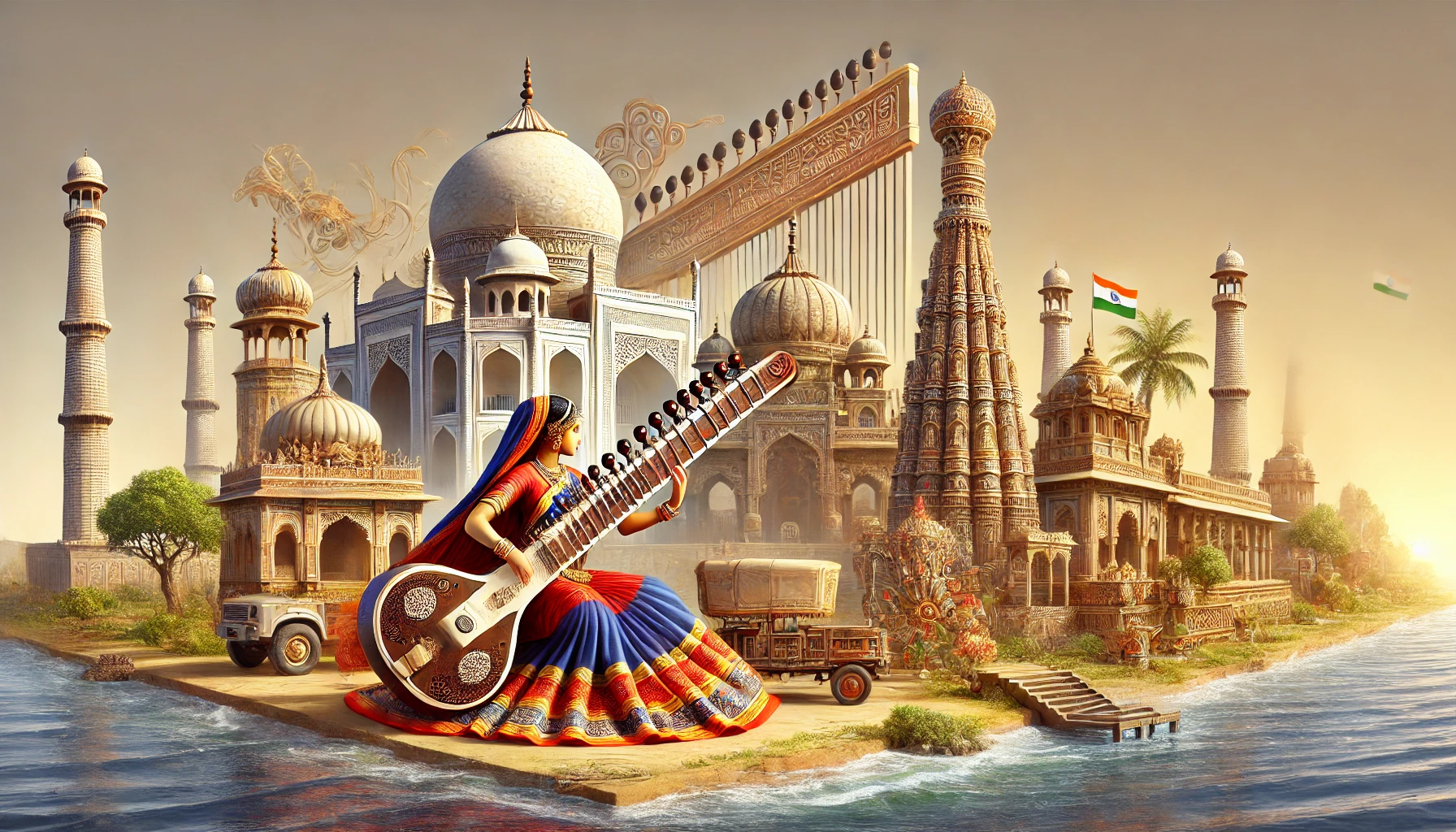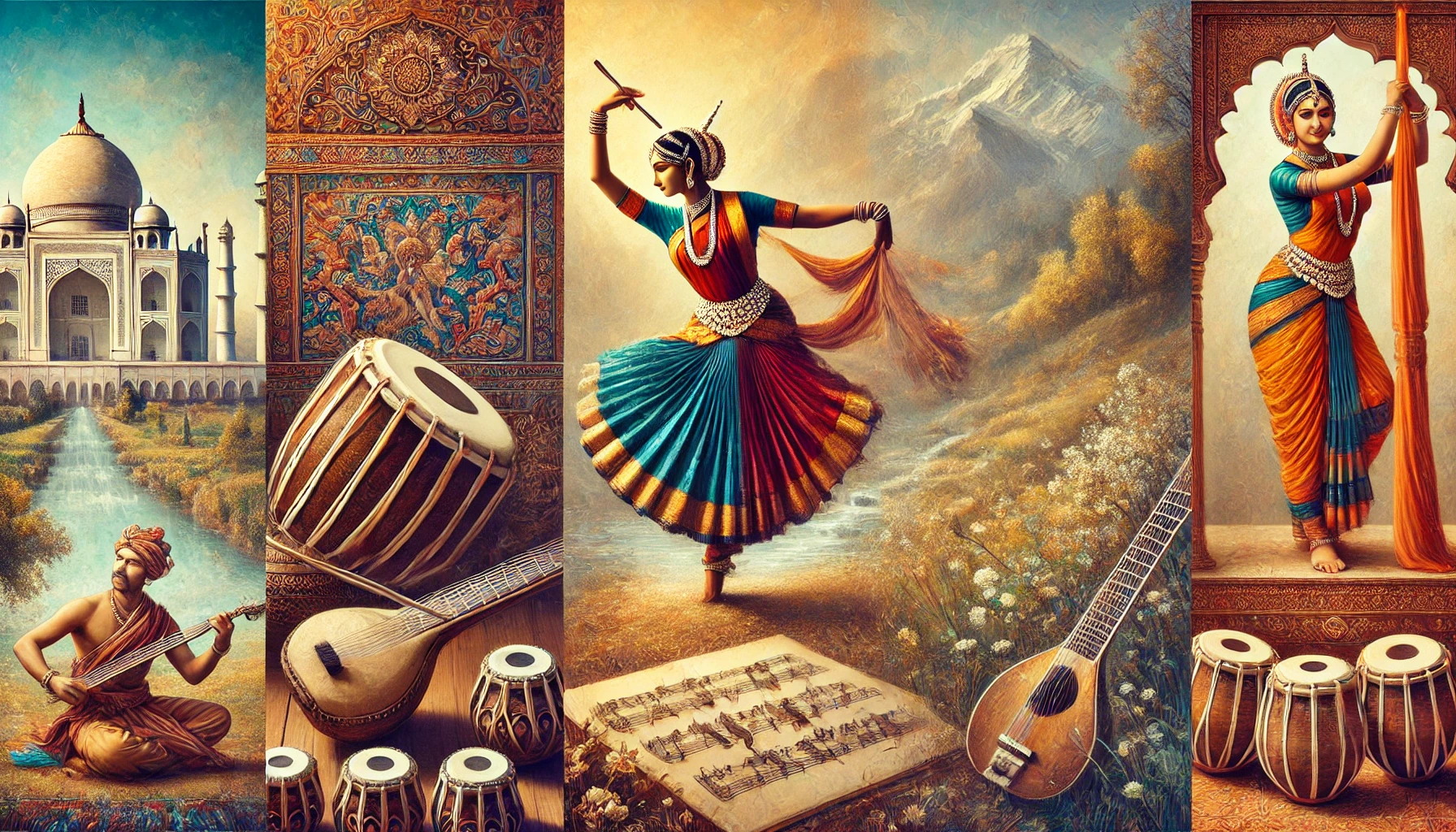The culture and art of India are a vibrant variety of stories, music, dance forms, and art forms reflecting a rich and diverse heritage. From ancient times, India has been a shelter of civilization. It nurtures many artistic traditions and cultural practices that continue to thrive today. The cultural variety shelters a wide array of languages, religions, dance forms, music, and festivals. Each contributing to the nation’s unique identity.
The classical arts of India, including Sattriya, Kathak, and Odissi dance forms, with Hindustani and Carnatic music, showcase the depth of the culture and art of India. Traditional crafts like pottery, weaving, and sculpture further highlight the intricate craftsmanship and aesthetic sensibilities of Indian artisans. Temples, forts, and monuments across the country stand as a testament to the architectural brilliance and artistic achievements of various historical periods.
Modern India continues to celebrate and innovate upon its cultural legacy. Contemporary art forms, cinema, and literature draw inspiration from traditional motifs while addressing current social themes. It ensures the relevance and dynamism of Indian culture. For UPSC aspirants, understanding India’s cultural and artistic heritage is crucial. It forms a significant part of the syllabus and provides valuable insights into the nation’s identity and values.

Culture and Art of India
The culture and art of India is a rich and diverse heritage reflecting centuries of civilization. Having numerous languages, religions, dance forms like Bharatanatyam and Kathak, and music genres such as Hindustani and Carnatic, India’s cultural variety is vast. Traditional crafts, intricate architecture, and vibrant festivals highlight its artistic legacy. Modern Indian art, cinema, and literature continue to evolve, blending tradition with contemporary themes. It showcases the nation’s enduring and dynamic cultural identity.
Culture encompasses the social behavior, norms, knowledge, beliefs, arts, laws, customs, capabilities, and habits of the individuals in these groups. Art, on the other hand, is a more visible expression of culture through various forms such as paintings, sculpture, performances, and music.
Significance in Indian Context
India, often described as a subcontinent, hosts a multitude of cultural and artistic expressions that vary dramatically . The diversity is an evidence to the country’s long history of migrations, invasions, and trade, which has contributed to the rich cultural variety.
Historical Evolution of the Culture and Art of India
The historical evolution of Indian art and culture spans millennia. It begins with the Indus Valley Civilization’s sophisticated urban planning and craftsmanship. Vedic and post-Vedic periods saw the development of Sanskrit literature, early religious practices, and classical music and dance forms. The Maurya and Gupta empires contributed significantly to architecture, sculpture, and the flourishing of Buddhist art. The medieval period witnessed the synthesis of Hindu, Islamic, and regional styles. It led to diverse art forms like Mughal miniatures and South Indian temple architecture. Colonial and post-independence eras introduced Western influences, bringing up a fusion of traditional and modern artistic expressions.
Ancient Period
- Indus Valley Civilization: The Indus Valley Civilization is known for its urban planning, and excellent craftsmanship in pottery, seals, and metallurgy.
- Vedic Period: Vedic period is marked by the composition of the Vedas, which laid the foundational cultural ethos of later Indian society.
Medieval Period
- Islamic Influence: Islamic Influence introduced new art forms like miniature painting and architectural styles evident in monuments like the Taj Mahal.
- Bhakti and Sufi Movements: Bhakti and Sufi movements promoted a unique culture of devotional music and poetry.
Modern Period
- Colonial Impact: The Colonial rule brought Western styles and led to the fusion in art and architecture. The Bengal School of Art emerged during this time.
- Post-Independence Renaissance: Post-Independence Renaissance is marked by a revival in traditional crafts, folk dances, and music, supported by government initiatives.
Major Art Forms in India
India’s major art forms encompass classical dance styles like Bharatanatyam, Kathak, and Odissi, reflecting rich cultural traditions. Music is divided into Hindustani and Carnatic, each with distinct styles and instruments. Visual arts include intricate Mughal miniatures, vibrant Madhubani paintings, and elaborate temple sculptures. Folk arts like Warli painting and Pattachitra capture rural life and mythology. Contemporary Indian cinema, known as Bollywood, blends traditional storytelling with modern themes, contributing to India’s dynamic cultural landscape.
Visual Arts
- Painting: Paintings in India range from the ancient murals of Ajanta to the contemporary works of M.F. Husain.
- Sculpture: Sculptures in India range from the rock-cut temples of Ellora to the modern sculptures of Ramkinkar Baij.
Performing Arts
- Dance: Dance in India ranges from Classical forms like Bharatanatyam from Tamil Nadu and Kathak from North India to popular folk dances like Bhangra of Punjab and Garba of Gujarat.
- Music: Music in India ranges from classical (Carnatic and Hindustani) to folk and modern Bollywood music.
Literary Arts
- Classical Literature: The Classical literature of India includes Sanskrit texts like Vedas, Upanishads, and epics such as Mahabharata and Ramayana.
- Modern Literature: Modern Literature of India includes works by Rabindranath Tagore, R.K. Narayan, among others.

Cultural Institutions and Preservation
India’s cultural institutions play a vital role in preserving and promoting its rich heritage. Organizations like the Archaeological Survey of India (ASI), the National Museum, and various state-run museums safeguard historical artifacts and monuments. Institutions such as the Sangeet Natak Akademi, Lalit Kala Akademi, and Sahitya Akademi support performing arts, visual arts, and literature. UNESCO World Heritage Sites in India further enhance global recognition and conservation efforts. It ensures that the country’s diverse cultural legacy endures for future generations.
Government Initiatives
- Archaeological Survey of India (ASI): The Archaeological Survey of India is responsible for archaeological studies and the preservation of cultural heritage. It is India’s premier archaeology agency. It conducts archaeological surveys and excavations to discover, maintain, and protect the cultural heritage of the nation.
- Zonal Cultural Centres: Zonal Cultural Centres are established to promote cultural arts and crafts. There are seven ZCCs across the country, each representing a different geographical zone and thus, a different cultural backdrop. These centers are instrumental in nurturing and promoting the traditional arts and crafts which are invaluable to India.
International Recognition
UNESCO World Heritage Sites in India represent the country’s rich cultural and natural heritage. These sites include ancient monuments, architectural marvels, and natural landscapes of outstanding universal value. Notable examples are the Taj Mahal, known for its stunning Mughal architecture, and the Ajanta and Ellora Caves, showcasing intricate rock-cut sculptures and paintings. Natural sites like the Western Ghats and Sundarbans National Park highlight India’s biodiversity. These sites are crucial for cultural preservation, education, and tourism, fostering global appreciation and conservation efforts for India’s diverse heritage.
Challenges in Preservation of Culture and Art of India
The preservation of India’s rich cultural and artistic heritage faces numerous challenges, including the impact of globalization and urbanization on traditional practices. Additionally, inadequate funding and awareness often hinder efforts to safeguard and revitalize historical art forms and cultural traditions
Neglect and Underfunding
Preservation of cultural artifacts, historical sites, and traditional arts requires substantial financial resources. Many historical sites and traditional arts lack sufficient financial support. This lack of support can lead to the deterioration of invaluable cultural assets.
Modernization and Westernization
Modernization and Westernization has led to the erosion of traditional values and art forms. Globalization presents a dual challenge; while it facilitates the exchange of cultural ideas and practices, it also promotes cultural homogenization. Traditional arts and practices may lose their unique identity as they are commercialized or adapted to appeal to global tastes, leading to a dilution of traditional cultural expressions.
Urbanization and Infrastructure Development
Rapid urbanization and the push for modern infrastructure development pose significant threats to cultural sites. Urban growth and construction activities can lead to the destruction of historical sites and potential archaeological locations.
Environmental Degradation
Environmental factors such as pollution, climate change, and natural disasters also threaten the physical integrity of cultural artifacts and monuments. Acid rain and increased air pollution can erode sculptures and monuments. Climate-induced changes can lead to the flooding or desertification of historical sites.
To overcome these challenges, a multi-faceted approach is required, involving government support, community engagement, international cooperation, and the use of modern technology. Addressing these issues is vital for preserving the cultural heritage for future generations. It is important for maintaining national identity and promoting diverse cultural expressions.
Relevance
Studying India’s culture and art provides UPSC aspirants with a deep understanding of the nation’s historical evolution, enriching their knowledge for General Studies Paper I. Awareness of diverse cultural heritage, including dance, music, festivals, and languages, aids in appreciating India’s unity in diversity, crucial for essays and interviews. Understanding historical contexts, such as the impact of empires and religions on art, enhances comprehensive answers in history and culture segments. Insights into cultural preservation and UNESCO World Heritage Sites relate cultural topics to current affairs. This fosters critical thinking, analytical skills, and knowledge of cultural diplomacy, supporting International Relations topics, and ensuring holistic exam preparation.
| Culture and Art of India UPSC Notes |
| 1. Indian culture and art have evolved over millennia, influenced by various dynasties, religions, and philosophical thoughts, reflecting a rich tapestry of diversity and unity. 2. The ancient period witnessed the flourishing of Harappan art, characterized by seals, pottery, and sculptures, followed by the Vedic age with its emphasis on oral traditions and sacrificial rituals. 3. Classical Indian art reached its zenith during the Mauryan and Gupta periods, with the creation of iconic sculptures, stupas like Sanchi, and the development of distinct architectural styles such as rock-cut caves in Ajanta and Ellora. 4. Medieval Indian art saw the synthesis of indigenous and Persian styles, especially under the Mughal Empire, leading to masterpieces in miniature paintings, calligraphy, and monumental architecture like the Taj Mahal. 5. The Bhakti and Sufi movements brought about significant changes in Indian music, dance, and literature, emphasizing devotional themes and expressions, leading to the creation of classical dance forms like Bharatanatyam and Kathak. 6. Indian folk and tribal arts, such as Warli paintings, Madhubani art, and Tanjore paintings, continue to thrive, preserving the traditions and cultural heritage of various communities. 7. The colonial period introduced Western artistic influences, leading to new forms and styles in Indian art, such as the Bengal School of Art, and modernist approaches by artists like Raja Ravi Varma. 8. Preservation of Indian art and culture involves efforts by governmental and non-governmental organizations, including the establishment of institutions like the Archaeological Survey of India (ASI) and initiatives for the conservation of heritage sites, promotion of traditional arts, and documentation of intangible cultural heritage. |
